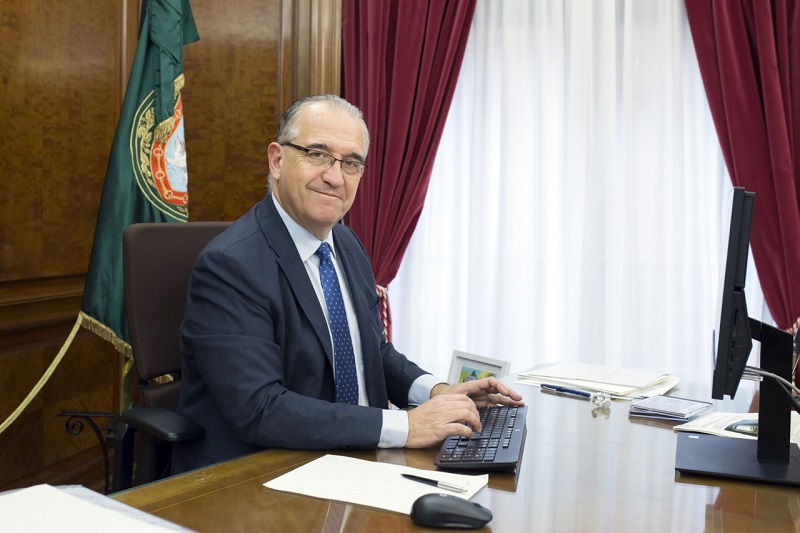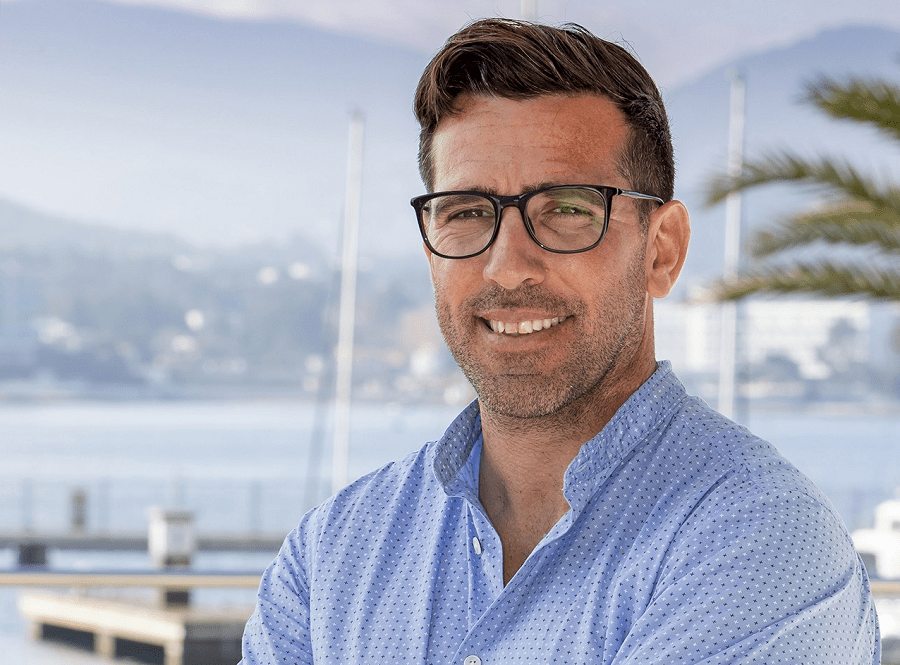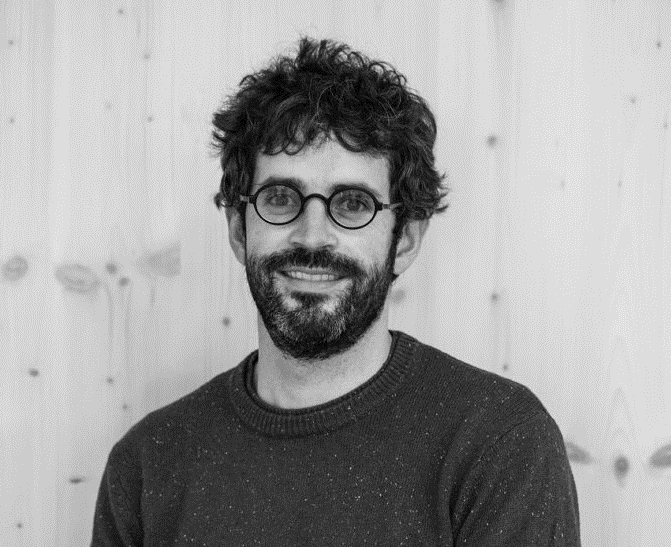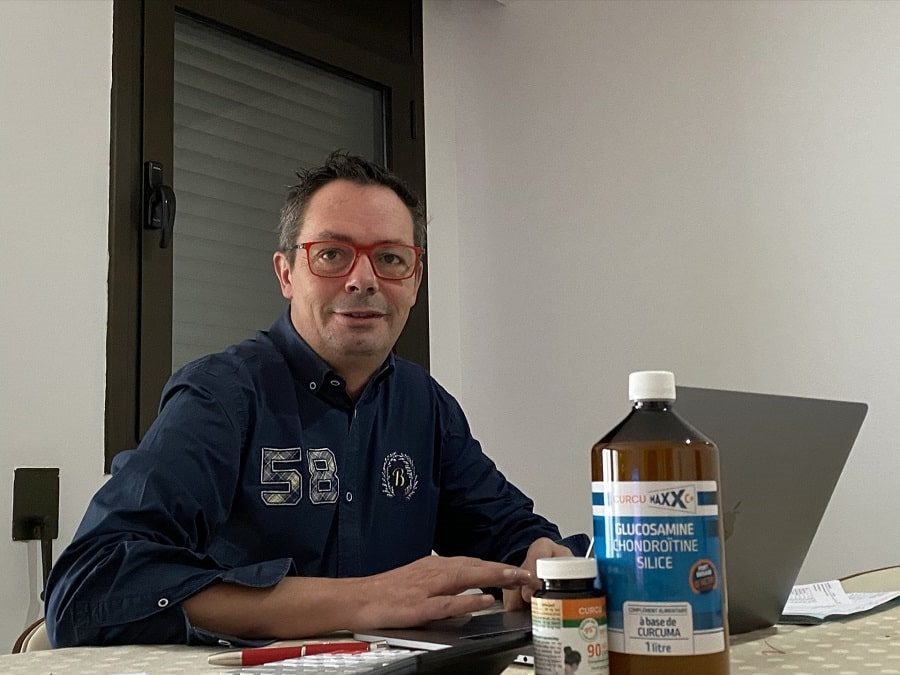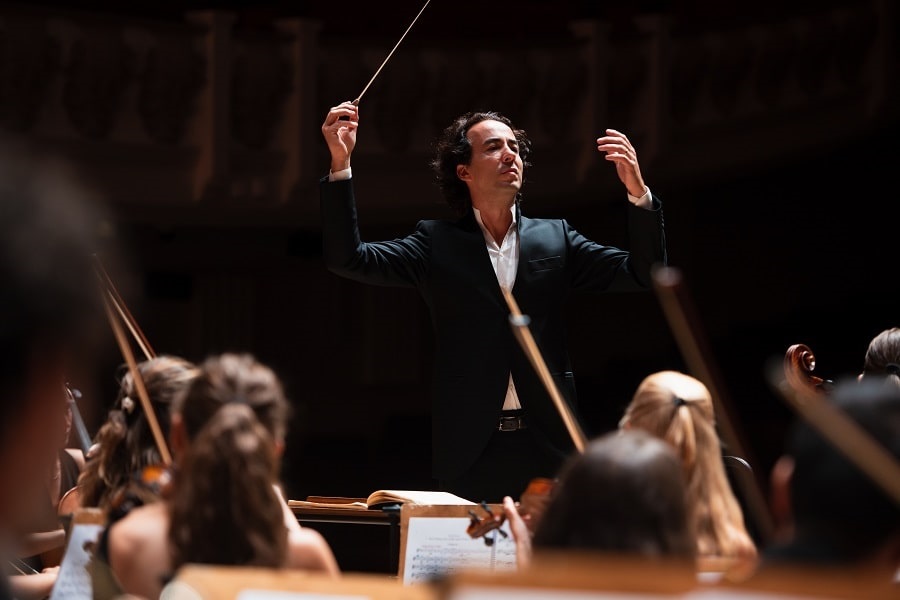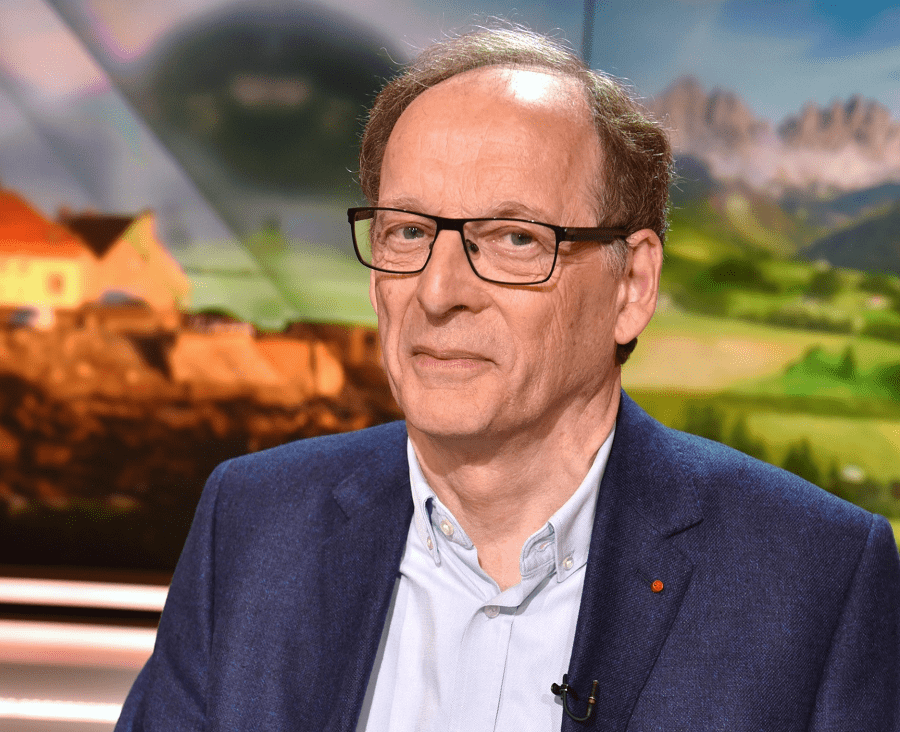Pamplona is the capital of the province of Navarre in northern Spain. The city is best known for her celebration of Sant Fermi (running of the bulls), widely celebrated in July. The city is also an important stop on the Camino de Santiago, a medieval pilgrimage route. The main foreign investor in Pamplona is the German automobile concern Volkswagen. Pamplona’s Mayor, Enrique Maya Miranda, tells us about the characteristics of life in Pamplona, its rich cultural life, as well as the main plans and tasks ahead.
Interview: Ximena Bravo
In which areas does the Pamplona City Council invest the most resources? Why?
The existing legislative body of Pamplona identified following priorities: mobility and sustainability, promoting urban development through activities that promote the economy of the city, efficient use of natural resources, a stable tax base that does not bring further tax burden on citizens. At the same time, we do not lose sight of the social protection of the most vulnerable members of our society.
The current budget structure for 2019, as well as the draft budget for 2020, which is now getting approved, responds to the need to provide basic public services and social assistance services: 42% of the budget is the cost of utilities (public safety, road maintenance, public cemetery,
landscaping, street lighting, etc.); another 25% of the budget is dedicated to social protection and the community action services.
Approximately 15% of resources are allocated for economic and administrative services and 18% – for activities related to culture, youth affairs, health care or education.
Does Pamplona City Council have a strategic tourism development plan?
Currently, a tourism development plan is in place, initiated by the previous legislative body (2017 to 2019). Tourism is an important sector of Pamplona’s economy. Now we are developing a new plan, which will also be aimed at the development of the city and its further positioning as a tourism destination. Pamplona is more than the celebration of Sant Fermi’s day (that starts at noon on July 6, when a rocket (Chupinazo) is fired from the balcony of the city hall of Pamplona, announcing the start of the festival, and lasts till midnight on July 14, the city is immersed in endless, 204 hours, non-stop fun).
Our city is very rich in tourist attractions, and also has its own gastronomic traditions. Gastronomic tourism is our priority.
In addition, Pamplona is the first city on the Camino de Santiago path (El Camino de Santiago, the Way of St. James, the famous pilgrimage to the alleged tomb of Saint James in the Spanish city of Santiago de Compostela, the main part of which lies in Northern Spain) and we must actively promote it in this context.
Camino de Santiago is an important tourist theme. The number of pilgrims staying in our city is 26% of the total volume of tourists. Among them are mostly those of the three communities: Catalonia, Madrid community and Valencian community. In terms of foreign visitors, the most numerous are citizens of France (12%), the USA (9%) and Italy (8%).
We are also working on the La Vía Carlomagno project, which is one of 40 tourist routes approved by the Council of Europe. We are very pleased that Pamplona is one of the cities that are part of the route of Charlemagne.
Finally, we want to bet on business tourism and regularly hold various congresses in our city. Just a few weeks ago we were at a fair in Barcelona, where we identified our priorities.
Tourists of which countries are the most frequent guests to Pamplona?
We can say that there are two types of tourists that come to Pamplona. Some tourists visit the city throughout the year, other ones come specifically for the holiday of Sant Fermi. During this holiday, our tourist office served more than 5,000 people. Among them – the citizens of Basque country, Madrid, Barcelona, Valencia. The number of international tourists is growing: people come to us from France, the USA, Italy, Great Britain, Germany… The number of Japanese and Chinese visiting Pamplona during the holiday has also grown significantly in recent years.
In addition, the percentage of family tourism increased, as well as, the demand for guided tours, also gastronomic and cultural events were more often visited by tourists from abroad. Our city often hosts tourist groups – from Germany, the USA, France, Great Britain, Japan and South Korea.
I suggest that you take a walk around the Plaza del Ayuntamiento to see that tourism in Pamplona is becoming increasingly popular, at any time of the year. I would also recommend taking a walk through the old city, along our beautiful streets, which are impossible not to fall in love with.
Please tell us more about the holiday of Sant Fermi. How is the city getting ready for this holiday? What other festivals or cultural events take place in the city? What are the plans for 2020?
The Pamplona City Council works throughout the year to host the city’s main holiday, Sant Fermi, improving cultural programs from year to year. It is an extremely popular street festival.
As part of the celebration, we hold an international competition of fireworks and many concerts. It is worth noting that each such event involves the whole city’s preparation: hotels, restaurants, security and cleaning work… Therefore, almost all municipal services are involved in it.
Throughout the city, the city council offers a rich cultural program. For example, CIVIVOX local cultural events, which bring together various districts and neighbourhoods of the city.
Throughout the year, the city council organizes various exhibitions and cultural programs at the Citadel of Pamplona (an old military Renaissance fort built between the 16th and 17th centuries).
The city has the Municipal Theater Gayarre where, in the spring, various festivals are held, such as Tourmaline, Festival de las Murallas and in the summer – Flamenco On Fire.
In autumn, we hold events as part of the “Privilegio de la Unión” program, as well as, the “Pimpam Ville” festival.
All these events, as well as some others, will be held in 2020.
At Christmas, the city’s most important program is the Festival Santas Pascuas, as well as the Christmas Council program, which is a series of Christmas concerts, children’s plays and installations. The Citadel will host events for children “Otras Luces y Toko Toko”.
Regarding immigration to Pamplona, what were the dynamics over the past 3-5 years? What is the origin of immigrants? How many immigrants live in the city? What is the educational level of the immigrant population?
Over the past year, the number of registered immigrants in Pamplona has grown by 1,651, reaching a total of 23,200 people. In 2012, the number of immigrants amounted to more than 25,000 people, so we can talk about the downward trend in the number of immigrants.
The main nationalities are Morocco, Romania, Portugal, Ecuador, Peru, Colombia, China, Ukraine… As for the level of education, I would not dare to say that it is average. In most cases, the degrees that immigrants receive in their countries cannot be confirmed here. So for us, it’s like they don’t have any degree.
In terms of cultural diversity, do you plan to promote the integration of various “ethnic groups” in the city? What problems does Pamplona face?
Cultural diversity is the potential of our city. Different ethnic groups coexist in the city. Some grants were allocated in November to 115 organizations and collectives, for the implementation of 126 projects (this is 13% more than in the previous year). All of them set themselves the goal of promotion and dissemination of various cultures that coexist in our city. Among them are the houses of Cantabria, Castile and Leon, Aragon, the Arab Cultural Association (Asociación Cultura Árabe), the Association of Colombians (Asociación de Colombiano), the Association of Tango and Argentine Folklore (Asociac Tango y Folclore Argentino).
Pamplona’s cultural diversity is rich and must be maintained and strengthened. We want to work on this issue, hand in hand with the government of Navarre, and we ask them for their assistance in solving the challenge that we have in Milagrosa (one of the districts of Pamplona), where there is a settlement of Gypsies of Romanian origin. There is a situation of social exclusion, which, together with their socio-cultural customs, has caused serious problems of coexistence. The City Council intends to develop a Strategy for the Development of the Gypsy Population of Navarra (2018–2021), to conduct a “social diagnosis” of the Romanian Gypsies in Milagros in order to find a solution to the problems and take measures.
What is the situation in terms of women’s rights and opportunities? Does the city have issues of gender inequality?
The issue of equality has been on the political agenda for many years. In 2006, the First Equality Plan was approved; to date, three such plans have been implemented. The latest plan was approved in 2016 with the goal of ensuring equal rights for men and women in the Pamplona City Council. We want to continue the implementation of these plans aimed at promoting the employment of women, strengthening the municipal service for women and its program coordinating the protection of women and children. In addition, we consider it important to continue to expand information campaigns to combat violence against women, to raise awareness. Pamplona has for many years been a leader in the fight against violence against women and the promotion of equality.
What can you tell about the economy of Pamplona?
It is a city with a strong economy based on the industrial sector (automobile industry) and the service sector dominated by health care. The city has a private health centre of high quality and prestige, recognized internationally, as well as three universities: two state ones and one private.
Pamplona also has two research centres that have joined the IdiSNA (El Instituto de Investigación Sanitaria de Navarra). This is one of the main examples of public-private cooperation.
IdiSNA is an interdisciplinary and translational biomedical research space focused on basic, clinical, epidemiological research in the field of healthcare. It includes: University Hospital of Navarre (Clínica Universidad de Navarre, CUN), Hospital Complex of Navarra (Complejo Hospitalario de Navarre, CHN), University of Navarre (Universidad de Navarra), State University of Navarre (Universidad Pública de Navarra), Center for Applied Medical Research (Centro para la Investigación Médica Aplicada, CIMA), Navarrabiomed, Institute of Public and Professional Health Care and First Aid of the Navarra Health Service (Instituto de Salud Pública y Laboral y Atención Primaria del Servicio Navarro de Salud).
Unlike IIS, accredited in other autonomous communities, IdiSNA covers the vast majority of existing medical researchers of Navarra and therefore has a very important integration character that allows to join efforts and achieve common goals.
The city’s unemployment rate is 8.19%, which is the second-lowest rate among the autonomous regions of Spain. In Pamplona, there are 10,844 unemployed, (42% of which are men and 58% women). We must work to reduce this indicator, therefore we attach great importance to those sectors that can contribute to that.
Are there many foreign investors in the city? What sectors of the economy are most popular among them?
The main foreign investor is Volkswagen, a company that plays a crucial role in the economy of Pamplona and its surrounding. The automotive sector in our city is very developed.
We know that the Pamplona City Council is actively supporting local businesses. What exactly is being done in this regard?
Local commerce is one of the engines of the urban economy for us. Since the establishment of the legislature, we have met with various associations to learn what are their challenges and their suggestions for commerce promotion.
The city hosts several fairs to promote local trade. Since 2007, the Stock Pamplona Fair has been held, it has been organized in collaboration with various associations to showcase their products in one place.
We hold a Book Day, and it is of great importance to all booksellers in the city, and also has a wide public response.
We also hold the medieval Tres Burgos fair, which sells handicrafts – it takes place in the old town.
In autumn, we organize La Nuit, an event during which all retail establishments are open throughout the night. It is accompanied by cultural events that attract more visitors.
Christmas is the time when classes are held for kids in the central parts of the city, such as el Paseo Sarasate, and this also stimulates trade.
As for the old bus station and Geltoki urban space, what are your plans for the future? Will it be reconstructed?
This symbolic place in Pamplona is one of the most controversial. What to do with the old bus station is a very difficult question. Geltoki space is a temporary use of the bus station, the concession is valid for seven years. We would like the bus station to remain a unique and symbolic place, which would become the starting point of cultural and economic activities. We are looking for a solution that will be beneficial to Pamplona, its citizens and merchants.
Please tell us about the Foros de Barrio program? How important is it for city residents? What is the percentage of citizens participating in this program?
These are the so-called “neighbourhood forums”, the purpose of which is to facilitate direct dialogue between citizens and the city council on issues related to a particular district so that people who work, live or do business there can communicate freely. There are currently 14 local forums. This is what the citizens really appreciate because they feel that they are part of something that we all do for our city together. I personally like to participate in such meetings, listen to what city residents are talking about,
As far as we know, Pamplona has a strategic plan for improving the city – PEU. What are its goals?
The plan is still under development. It aims to develop a model of the city based on the wishes of the inhabitants of Pamplona for universal consensus. The duration of this plan is 10 years, that is until 2030. It seems that much remains to be finalized, but time is running out, and the decisions that we are taking now have already become part of this plan. Despite the disagreements of the parties, we all want the best for Pamplona. In this regard, PEU is also being discussed in the neighbourhood forums, that we just talked about, in order to find out the citizens’ positions on certain issues, such as mobility or infrastructure.
For me, the benefits of this plan, except for the subsidies that the European Union can provide us, are to move forward together. In early December, we had another meeting with collectives and associations to discuss the details of this plan.
Let’s talk about the environment and sustainable development goals. What initiatives are you promoting? Do you have an environmental action plan?
Our goal is to keep promoting the plan for sustainable development and urban mobility in Pamplona, accelerating its implementation in accordance with the criteria of maximum realism and feasibility of proposals. Pamplona signed the UN Sustainable Development Plan of Action in 1998. The approval of the “letter of Aalborg” (Carta de Aalborg) involves the development of a “Local Agenda 21” in Pamplona.
We must continue to develop a mobility plan, always thinking about Pamplona, which we want to see in the future: much more responsible in matters of interaction with the environment.
For me, the education of a new generation in this context is especially important. Our children are much more aware of this problem than we are.
Our city has a museum of environmental education, which was municipalized in 2016 and holds various events. The museum itself has developed a program for sustainability education for 2019–2020. Environmental projects were widely represented at the school “Compasión o Larraona”.
We must continue to work to improve our city. And we must adapt to this world, which is changing day by day. There are professionals in all municipal services, from trade to culture and mobility, whose aim is to continue to work together to promote Pamplona and make it a reference city in all areas.



